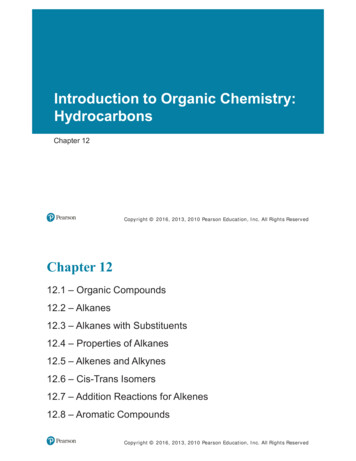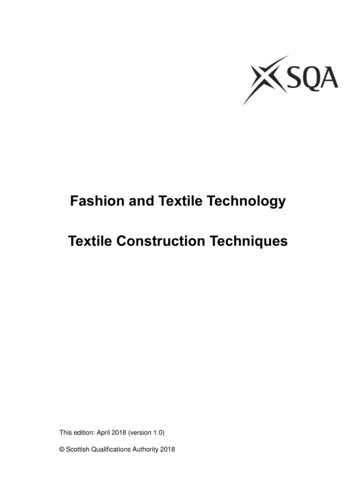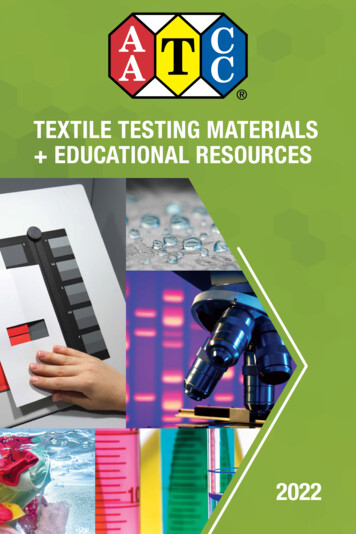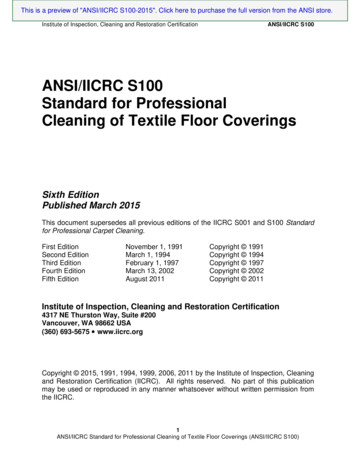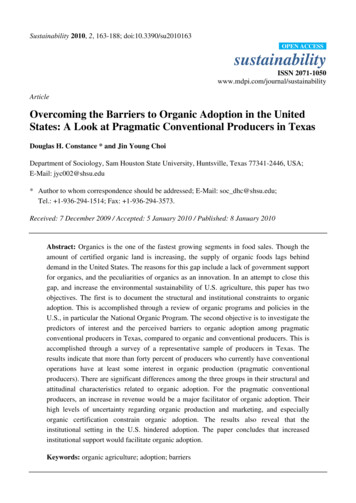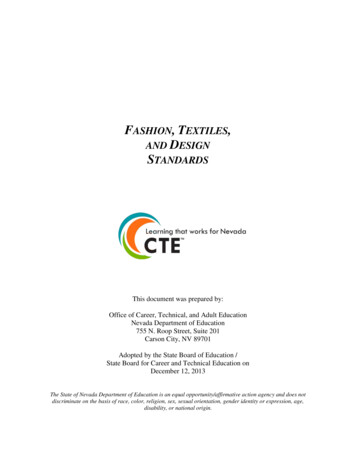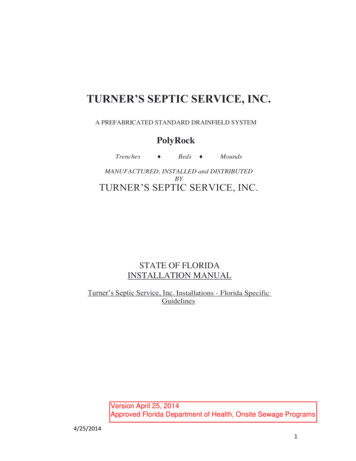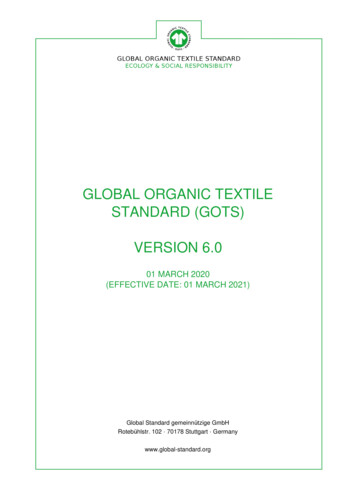
Transcription
GLOBAL ORGANIC TEXTILESTANDARD (GOTS)VERSION 6.001 MARCH 2020(EFFECTIVE DATE: 01 MARCH 2021)Global Standard gemeinnützige GmbHRotebühlstr. 102 · 70178 Stuttgart · Germanywww.global-standard.org
TABLE OF CONTENTSTABLE OF CONTENTS 212PRINCIPLES 31.1AIM OF THE STANDARD 31.2SCOPE AND STRUCTURE 31.3SCOPE CERTIFICATE 31.4LABEL GRADES AND LABELLING 31.5REFERENCE DOCUMENTS 4CRITERIA 52.1REQUIREMENTS FOR ORGANIC FIBRE PRODUCTION 52.2REQUIREMENTS FOR FIBRE MATERIAL COMPOSITION 52.3GENERAL REQUIREMENTS FOR CHEMICAL INPUTS IN ALL PROCESSINGSTAGES 52.434SPECIFIC REQUIREMENTS AND TEST PARAMETERS 10SOCIAL CRITERIA 213.1SCOPE 213.2EMPLOYMENT IS FREELY CHOSEN 223.3FREEDOM OF ASSOCIATION AND COLLECTIVE BARGAINING 223.4CHILD LABOUR SHALL NOT BE USED 223.5NO DISCRIMINATION IS PRACTISED 233.6OCCUPATIONAL HEALTH AND SAFETY (OHS) 233.7NO HARASSMENT AND VIOLENCE 243.8REMUNERATION AND ASSESSMENT OF LIVING WAGE GAP 243.9WORKING TIME 253.10NO PRECARIOUS EMPLOYMENT IS PROVIDED 253.11MIGRANT WORKERS 253.12SOCIAL COMPLIANCE MANAGEMENT 26QUALITY ASSURANCE SYSTEM 264.1AUDITING OF PROCESSING, MANUFACTURING AND TRADING STAGES 264.2TESTING OF TECHNICAL QUALITY PARAMETERS AND RESIDUES 275ETHICAL BUSINESS BEHAVIOUR 276ANNEX 286.1SPECIFIC REQUIREMENTS FOR TEXTILE PERSONAL CARE PRODUCTS 286.2SPECIFIC REQUIREMENTS FOR FOOD CONTACT TEXTILES 297DEFINITIONS 308LIST OF ABBREVIATIONS 31GOTS Version 6.0 · March 2020 · Page 2/33
1PRINCIPLES1.1AIM OF THE STANDARDThe aim of this Standard is to define requirements to ensure organic status of textiles, from harvestingof the raw materials, through environmentally and socially responsible manufacturing up to labelling inorder to provide a credible assurance to the end consumer.1.2SCOPE AND STRUCTUREThis Standard covers the processing, manufacturing, packaging, labelling, trading and distribution of alltextiles made from at least 70% certified organic natural fibres. The final products may include, but arenot limited to fibre products, yarns, fabrics, garments, fashion textile accessories (carried or worn), textiletoys, home textiles, mattresses and bedding products as well as textile personal care products.The Standard focuses on compulsory criteria only except where an exception from this rule is expresslystated. Some of the criteria are compliance requirements for the entire facility where GOTS productsare processed (2.4.10. Environmental management, 2.4.11. Wastewater treatment, 3. Minimum socialcriteria, 4.1. Auditing of processing, manufacturing and trading stages and 5. Ethical BusinessBehaviour), whereas the others are criteria relevant for the specific products subject to certification (allother criteria of Section 2 and Section 4.2. of this Standard). GOTS criteria or the local legalrequirements, whichever are higher, shall be followed.As it is to date technically nearly impossible to produce any textiles in an industrial way without the useof chemical inputs, the approach is to define criteria for low impact and low residual natural and syntheticchemical inputs (such as dyestuffs, auxiliaries and finishes) accepted for textiles produced and labelledaccording to this Standard.The Standard sets requirements on working and social conditions that are equivalent to those of leadingsocial sustainability standards.As the Standard is also applied and monitored for entities in countries with developed and effectivelyapplied social and labour legislation and collective agreements between employers and trade unionsthat conform with the universal standards of the International Labour Organisation (ILO), exceptions tomonitoring, verification and audit requirements may be made. Conditions for making exceptions aredefined in the Implementation Manual of this Standard.1.3SCOPE CERTIFICATEProcessors, manufacturers, traders and retailers that have demonstrated their ability to comply with therelevant GOTS criteria in the corresponding certification procedure to an Approved Certifier receive aGOTS Scope Certificate issued in accordance with the 'Policy and Template for issuing ScopeCertificates (SCs)'. Accordingly, they are considered Certified Entities. Scope Certificates list theproducts/product categories that the Certified Entities can offer in compliance with the Standard as wellas the processing, manufacturing and trading activities that are qualified under the scope of certification.Subcontractors and their relevant processing and manufacturing steps become listed on the ScopeCertificate of the Certified Entity assigning the certification.1.4LABEL GRADES AND LABELLINGThe Standard provides for a subdivision into two label-grades. The only differentiation for subdivision isthe minimum percentage of 'organic' / 'organic - in conversion' material in the certified product. Labellingof products as 'in conversion' is only possible, if the Standard, on which the certification of the fibreproduction is based, permits such labelling for the fibre in question.Only textile goods (finished or intermediate) produced in compliance with this Standard by a CertifiedEntity and certified by an Approved Certifier ( GOTS Goods) may be sold, labelled or represented as:GOTS Version 6.0 · March 2020 · Page 3/33
(a) "organic" or "organic - in conversion"or(b) "made with (x %) organic materials" or "made with (x %) organic - in conversionmaterials"and the GOTS logo (or the immediate reference “Global Organic Textile Standard” or the shortform “GOTS”).Labelling shall be completed by a reference to the Approved Certifier who has certified the GOTS Goods(e.g. certifier's name and/or logo) and the license number of the Certified Entity (as provided by theApproved Certifier).In all cases the GOTS labelling can only be applied to the product/packaging by a Certified Entity andshall have been approved by the Certified Entity's Approved Certifier in advance of its application.Labelling of GOTS Goods sold in retail is mandatory.Application of GOTS labelling shall be in compliance with the ‘Licensing and Labelling Guide’.1.5REFERENCE DOCUMENTSBeside this Standard the Global Standard gGmbH has released the following official referencedocuments that provide for binding provisions and requirements for Approved Certifiers and users ofthe GOTS:1.5.1 Manual for the Implementation of the Global Organic Textile Standard:provides interpretations and clarifications for specific criteria of GOTS. Its purpose is to preventany inconsistent, inappropriate or incorrect interpretation of the Standard. It further containsrequirements and detailed specifications for the application of the GOTS and the implementationof the related quality assurance system for certifiers.1.5.2 Licensing and Labelling Guide:specifies the licensing conditions for companies participating in the GOTS certification systemand defines the corresponding license fees. It further sets the requirements for the use of theGOTS registered trademarks.1.5.3 Labelling Release for GOTS Goods:provides a release form for labelling of GOTS Goods1.5.4 Labelling Release for GOTS Additives:provides a release form for labelling of GOTS Additives1.5.5 Policy and Template for issuing Scope Certificates (SCs):provides detailed instructions with regard to policies, layout, format and text for issuing ScopeCertificates.1.5.6 Policy and Template for issuing Transaction Certificates (TCs):provides detailed instructions with regard to policies, layout, format and text for issuingTransaction Certificates1.5.7 Policy and Template for issuing Letters of Approval:provides detailed instructions with regard to policies, layout, format and text for issuing Lettersof Approval for colourants and textile auxiliaries which are approved as inputs for application inthe processing of GOTS certified textile productsGOTS Version 6.0 · March 2020 · Page 4/33
1.5.8 Approval Procedure and Requirements for Certification Bodies:specifies the approval and monitoring procedures and sets out the related requirements forCertification Bodies to implement the GOTS certification and quality assurance system1.5.9 Policy for Change or Migration of Certifier:specifies the steps to be undertaken by Approved Certifier and Certified Entity in case of changeor migration of certifier.2CRITERIA2.1REQUIREMENTS FOR ORGANIC FIBRE PRODUCTIONApproved are natural fibres that are certified 'organic' or 'organic - in conversion' according to anystandard approved in the IFOAM Family of Standards for the relevant scope of production (crop oranimal production), such as Regulation (EC) 834/2007, USDA National Organic Program (NOP),APEDA’s National Programme for Organic Production (NPOP), China Organic Standard GB/ T19630.The certification body shall have a valid and recognised accreditation for the standard it certifies against.Recognised accreditations are ISO 17065 accreditation, NOP accreditation and IFOAM accreditation.Certifying of products as 'organic - in conversion' is only possible, if the standard on which thecertification of the fibre production is based, permits such a certification for the fibre in question.Conversion status of fibres shall be stated as specified in Section 1.4. of this Standard.2.2REQUIREMENTS FOR FIBRE MATERIAL COMPOSITION2.2.1 Products sold, labelled or represented as "organic" or "organic-in conversion”No less than 95% ( 95%) of the fibre content of the products - excluding accessories - shall be ofcertified organic origin or from 'in conversion' period (identified and labelled as specified in Sections1.4 and 2.1 of this Standard). Up to 5% ( 5%) of the fibre content of the products may be made ofnon-organic fibres that are listed under 'additional fibre materials' in Section 2.4.9. The percentagefigures refer to the weight of the fibre content of the products at normal conditions. No fibres shall beused which originate from production projects with regard to which there is evidence of a persistentpattern of gross violations of the ILO core labour norms (as far as these are relevant for agriculture)and/or of animal welfare principles (including Mulesing) or irrefutable evidence of a persistent patternof land grabbing methods.2.2.2 Products sold, labelled or represented as "made with x % organic materials" or"made with x % organic-in conversion materials"No less than 70% ( 70%) of the fibre content of the products - excluding accessories - shall be ofcertified organic origin or from 'in conversion' period (identified and labelled as specified in Sections 1.4and 2.1 of this Standard). Up to 30% ( 30%) of the fibre content of the products may be made of nonorganic fibres that are listed under 'additional fibre materials' in Section 2.4.9. The percentage figuresrefer to the weight of the fibre content of the products at normal conditions. No fibres shall be used whichoriginate from production projects with regard to which there is evidence of a persistent pattern of grossviolations of the ILO core labour norms (as far as these are relevant for agriculture) and/or of animalwelfare principles (including Mulesing) or irrefutable evidence of a persistent pattern of land grabbingmethods.2.3GENERAL REQUIREMENTS FOR CHEMICAL INPUTS IN ALLPROCESSING STAGES2.3.1 Prohibited and restricted inputsThe following table lists chemical inputs that may (potentially) be used in conventional textile processingbut that are explicitly banned or restricted for environmental and/or toxicological reasons in allGOTS Version 6.0 · March 2020 · Page 5/33
processing stages of GOTS Goods. It is not to be seen as a comprehensive and inclusive list of allchemical inputs that are prohibited or restricted under GOTS. Prohibition or restriction of substancegroups or individual substances that are not explicitly listed in this Section may further result fromSection 2.3.2 ‘Requirements related to hazards and toxicity’ or from other criteria of this Standard.Substance groupAromatic and/or halogenatedsolventsFlame retardantsChlorinated benzenes andtoluenesChlorophenols (including theirsalts and esters)Complexing agents andsurfactantsCriteriaProhibitedProhibited are- Chlorinated flame retardants- Brominated flame retardants- Phosphate based flame retardants, listed in Manual- Flame retardants containing Antimony or Antimony Trioxide- Disodium octaborateProhibitedProhibited (such as mono, di, tri, tetra and penta- chlorophenols)Prohibited are: all APs and APEOs (i.e. NP, OP, NPEO, OPEO, APEOsterminated with functional groups, APEO-polymers) EDTA, DTPA, NTA LAS, α-MESEndocrine disruptorsProhibitedFormaldehyde and other short- Prohibited are inputs that contain or generate formaldehyde orother short-chain aldehydes (like glyoxal) during designatedchain aldehydesapplicationGlycol DerivativesProhibited are the glycol derivatives listed in the ManualGenetically modifiedProhibited are all inputs that:organisms (GMO) contain GMO contain enzymes derived from GMO are made from GMO raw materials (e.g. starch, surfactants oroils from GM plants) GMO based traceability markersProhibited, inputs shall be ‘heavy metal free’. Impurities shall notHeavy metalsexceed the limit values as defined in annex B.Exceptions valid for dyes and pigments are set in Sections 2.4.6.and 2.4.7.Inputs (e.g. azo dyes andProhibitedpigments) releasingcarcinogenic arylaminecompounds (MAK III, category1,2,3,4)Inputs containing functionalProhibitednanoparticles ( particles witha size 100 nm)Inputs with halogen containing Prohibited are inputs that contain 1% permanent AOX.compoundsExceptions valid for pigments are set in Section 2.4.7.Organotin compoundsProhibited (such as DBT, DMT, DOT, DPhT, DPT, MBT, MMT,MOT, MPhT, TBT, TCyHT, TeBT, TeET, TMT, TOT, TPhT, TPT)PlasticizersProhibited are:PAH, phthalates and esters of phthalic acid, Bisphenol A and allother plasticizers with endocrine disrupting potentialGOTS Version 6.0 · March 2020 · Page 6/33
Substance groupPerandPolyfluorinatedcompounds (PFC)Quaternary ammoniumcompoundsChlorinated ParaffinsShort-chain chlorinatedparaffins (SCCPs, C10-13)Medium-chain chlorinatedparaffins (MCCPs, C14-17)Cyclic Siloxanes (D4, D5, D6)Substances and preparationsthat are prohibited forapplication in textiles with arecognised internationally or anationally valid legal characterSubstances and preparationshaving restrictions in usagefor application in textiles witha recognised internationally ornationally legal characterMicroplasticsIn-can preservatives inchemical inputsCriteriaProhibited. (such as PFCA (incl. PFOA), PFSA (incl. PFOS)FTOH, PFNA, PFHpA, PFDA)ProhibitedDTDMAC, DSDMAC and DHTDMACare:ProhibitedProhibitedProhibited are inputs that shall lead to 1000 ppm of cyclicsiloxanes in processed GOTS Goods.ProhibitedThe same restrictions apply, provided the substances andpreparations are not already prohibited or have stricter restrictionscriteria according to this Standard. Substances and preparationslisted in regulation EC 552/2009 (amending regulation EC1907/2006 (REACH), annex XVII), and the ‘candidate list ofsubstances of very high concern for authorisation’ of theEuropean Chemicals Agency (ECHA) are prohibited.Prohibited are:Intentionally added synthetic microplastics.Prohibited are:In-can preservatives which do not meet the requirements ofSections 2.3.1 and 2.3.2Except, allowed are:Biocidal active substance(s) that comply with European biocidalproducts regulation (BPR 528/2012) and listed on the Union list ofBPR for product type PT06 (preservatives for products on-on-chemicals/biocidalactive-substances2.3.2 Requirements related to hazards and toxicitySubstance groupInputs which are classifiedwith specific hazardstatements (risk phrases)related to health hazardsCriteriaProhibited are:- substances which are classified with any of the following hazardstatements, if applied as direct input- preparations which are classified with any of the following hazardstatements- preparations which contain at least one substance which isclassified with any of the following hazard statementsin accordance with the codification system of the GlobalHarmonized System (GHS) as published by the UnitedNations, annex 3:H300 Fatal if swallowedGOTS Version 6.0 · March 2020 · Page 7/33
Inputs which are classifiedwith specific hazardstatements / risk phrasesrelated to environmentalhazardsH310 Fatal in contact with skinH330 Fatal if inhaledH340 May cause genetic defectsH341 Suspected of causing genetic defectsH350 May cause cancerH351 Suspected of causing cancerH360 May damage fertility or the unborn childH361 Suspected of damaging fertility or the unborn childH370 Causes damage to organsH371 May cause damage to organsH372 Causes damage to organs through prolonged orrepeated exposureFor inputs assessed on basis of GHS, where the implementationsystem does not provide for the codified H-statements, thecorresponding hazard classes and categories of GHS, annex 3 apply.For inputs assessed according to the 'risk phrase' classification(Directive 67/548EEC amended and appealed by Regulation EC1272/2008) the equivalent risk phrases apply.Prohibited are:- substances which are classified with any of the followinghazard statements / risk phrases, if applied as direct input- preparations which are classified with any of the following hazardstatements / risk phrasesa) in accordance with the codification system of theGlobal Harmonized System (GHS) as published by the UnitedNations, annex 3:H400: Very toxic to aquatic lifeH410: Very toxic to aquatic life with long lasting effectsH411: Toxic to aquatic life with long lasting effectsH420: Harms public health and the environment by destroyingozone in the upper atmosphereH433: Harmful to terrestrial vertebratesInputs which are bioProhibited are substances, if applied as direct input, andaccumulative and not rapidly preparations classified with H413: 'May cause long-lastingdegradableeffects to aquatic life' (respective R53) that are both, ‘bioaccumulative’1) and not rapidly degradable2), 3)1) All substances or preparations are considered as (potentially) bio-accumulative, if BCF ( bio-concentrationfactor) 500 or, if absent, log Kow ( logarithm of the n-octanol-water partition coefficient) 42) Testing requirement: 70% OECD 301A [28d] or equivalent testing method according to footnote 4 of the tablebelow, except test methods related to eliminability (OECD 302). In those cases where only BOD and COD dataare available the input is considered 'rapidly degradable' when the ratio of BOD5/COD is 0,5.3) This criterion is not applicable to preparations whose very low solubility in water prevents their bioaccumulation(e.g. pigment preparations)GOTS Version 6.0 · March 2020 · Page 8/33
All preparations applied shall further comply with the following requirements:ParameterOral Toxicity 1)Aquatic Toxicity 3)Relation of biodegradability / eliminability 4) toaquatic toxicity 3)CriteriaLD50 2000 mg/kg 2)LC50, EC50, IC50 1 mg/lOnly allowed, if: 70% and 100 mg/l 70% and 10 mg/l 95% and 1 mg/l1) Performing new animal tests to determine unknown LD50 values in the course of the GOTS assessmentprocedure for inputs (refer to Section 2.3.3) is prohibited. Instead, alternative methods (e.g. Acute ToxicityEstimates (ATE); conclusions on analogy from similar products; validated structure-activity relationships;calculation from available data of substances contained; expert judgment; in vitro tests) shall be used todetermine unknown values.2) Substances and preparations, such as alkalis and acids that fail to meet this requirement because of their pHvalue only, are exempt from this requirement.3) Performing new fish and daphnia tests to determine unknown LC 50 / EC50 values in the course of the GOTSassessment procedure for inputs is prohibited. Instead, alternative methods such as Acute Toxicity Estimates(ATE); validated structure-activity relationships; conclusion on analogy from similar products; calculation fromavailable data of substances contained; fish egg test (embryo toxicity test (FET)); in vitro test; IC50 algae; OECD201 [72hr] shall be used to determine unknown values.4) Accepted test methods: OECD 301A, OECD 301E, ISO 7827, OECD 302A, ISO 9887, OECD 302B, ISO 9888or OECD 303A; alternatively, to meet the 70% level a preparation tested with one of the methods OECD 303Aor ISO 11733 a percentage degradation of at least 80% shall be shown - or if tested with one of the methodsOECD 301B, ISO 9439, OECD 301C, OECD 302C, OECD 301D, ISO 10707, OECD 301F, ISO 9408, ISO10708 or ISO 14593, a percentage degradation of at least 60% shall be shown. To meet the 95% level, if testedwith any of the mentioned methods, a percentage degradation of 95% shall be shown. Testing duration witheach method is 28 days.2.3.3 Assessment of chemical inputsAll chemical inputs intended to be used to process GOTS Goods are subject to approval by a GOTSApproved Certifier prior to their usage. Preparations shall have been evaluated and their trade namesregistered on approved lists prior to their usage by a GOTS Approved Certifier who is authorised by theGlobal Standard gGmbH for the specific accreditation scope: “Approval of textile auxiliary agents(chemical inputs) on positive lists” (Scope 4).Approval shall be applied by the applicable chemical producer or supplier of the preparations whoreceive conformity documents (Letters of Approval) issued by the authorised certifiers and containingthe trade names of applied preparations that have been found to be compliant with the criteria of thisStandard.For all chemical inputs (substances and preparations), a Material Safety Data Sheet (SDS), preparedaccording to an applicable recognised norm or directive shall be available. The Approved Certifiers arerequested, where appropriate and felt necessary, to include further sources of information (such asadditional toxicological and environmental data on specific components of the auxiliary agents, testreports, independent lab analysis and traceability checks of ingredients, no intentional use declarations,sources of data for hazard & toxicity, etc.) in the assessment.Certified Entities shall have copies of valid Letters of Approval on hand listing all preparations they areusing in processing and manufacturing GOTS Goods as verification proof that all colourants and textileauxiliaries used for GOTS Goods are actually approved.2.3.4 Product Stewardship of chemical inputsChemical formulators shall implement appropriate and effective product stewardship practices.Adequate systems for product testing and quality assurance shall be in place.GOTS Version 6.0 · March 2020 · Page 9/33
2.3.5 Environment, Health and Safety for Chemical SuppliersChemical formulators shall undergo environmental management system and safety audit of theirpremises. On-site inspection shall be performed for the first year and every 3rd year of granted Letter ofApproval or Standard Revision, whichever is earlier.Following GOTS criteria shall be included in the audit of a chemical supplier: Section 2.4.10Section 2.4.11, (see Manual for COD requirements).Section 3.6Above criteria is applicable to whole facility for the whole year.At all stages through the chemical manufacturing and distribution, adequate measures for Separationand Identification shall be established. It shall be ensured that GOTS Approved inputs and otherchemicals are not commingled and GOTS Approved inputs are not contaminated by contact withprohibited substances.2.4SPECIFIC REQUIREMENTS AND TEST PARAMETERS2.4.1 Separation and IdentificationAll stages through the supply chain shall be established so as to ensure that organic and conventionalfibres are not commingled and that organic fibres and GOTS Goods are not contaminated by contactwith prohibited substances.All organic raw materials and GOTS goods shall be clearly labelled and identified as such at all stagesof the supply chain.2.4.2 SpinningAllowed are additives which meet the basic requirements as set in Sections 2.3.1. and 2.3.2. only. Anyparaffin products used shall be fully refined with a limited value for residual oil of 0.5%. Machine oils thatmay come in contact with GOTS goods shall be heavy metal-free.Synthetic fibres, which are to be dissolved at a later processing stage, are not allowed to be used.2.4.3 Sizing and weaving / knittingAllowed sizing agents include starch, starch derivatives, other natural substances and CMC(carboxymethylcellulose).Synthetic sizes which meet the basic requirements as set in Sections 2.3.1. and 2.3.2. may be used forno more than 25% of the total sizing in combination with natural substances only, calculated for thechemical without water. In case such synthetic sizes are recycled/recovered in the wastewater fromdesizing process with a ratio 80% they may be used without limitation in the total sizing but shall stillmeet the requirements as set in Sections 2.3.1 and 2.3.2.Machine oils that may come in contact with GOTS goods shall be heavy metal-free. Other inputs shallbe derived from natural materials only.2.4.4 Non-woven manufactureAllowed non-woven manufacturing processing includes only mechanical compaction, webbing andentangling such as hydro entanglement.2.4.5 Pre-treatment and other wet processing stagesTreatment / processCriteriaAmmonia treatmentProhibitedGOTS Version 6.0 · March 2020 · Page 10/33
Treatment / processCriteria- Exception: allowed for after-treatment of wool, if performed in closedsystem.BleachesOn basis of oxygen only (peroxides, ozone, etc.). Approved Certifiersmay grant exceptions for non-cotton fibre products where oxygenbleaches are not sufficiently functional, provided they meet the basicrequirements as set in Sections 2.3.1. and 2.3.2.Boiling, kiering, washingAllowed are auxiliaries that meet the basic requirements as set inSections 2.3.1. and 2.3.2. only. Washing detergents shall not containphosphates.Chlorination of woolsProhibitedDesizingAllowed are GMO free enzymatic desizing and other auxiliaries thatmeet the basic requirements as set in Sections 2.3.1. and 2.3.2. onAllowed with auxiliaries that meet the basic requirements as set inSections 2.3.1. and 2.3.2. only. Alkali shall be recycled.Optical brighteningAllowed are optical brightening agents (OBAs) that meet all criteria forthe selection of dyes and auxiliaries as set in Section 2.4.6. Dyeingonly.Other, not explicitly listedpre-treatment methodsAllowed are mechanical / thermal pre-treatment methods and such withthe use of substances on basis of natural materials.2.4.6 DyeingParameterCriteriaSelection of dyes andauxiliariesAllowed are natural dyes, synthetic dyes, pigments and auxiliaries thatmeet the requirements as set in Sections 2.3.1 and 2.3.2. only.Prohibited are (disperse) dyes classified as sensitizing / allergenic.Prohibited are colourants classified as carcinogenic or suspectedcarcinogenic (H350 / H351).Prohibited are dyes containing heavy metals as an integral part of thedye molecule (e.g. heavy metal dyes, certain reactive dyes) underconsideration of the following exceptions:- General exception for Iron- Specific exception for copper: permitted up to 5% by weight in blue,green and turquoise dyestuffs.The use of natural dyes and auxiliaries that are derived from athreatened species listed on the Red List of the IUCN is prohibited.2.4.7 PrintingParameterSelection of dyes,pigments and auxiliariesCriteriaAllowed are dyes, pigments and auxiliaries that meet the requirementsas set in Sections 2.3.1 and 2.3.2 only.Prohibited are (disperse) dyes classified as sensitizing / allergenic.Prohibited are colourants classified as carcinogenic or suspectedcarcinogenic (H350 / H351).GOTS Version 6.0 · March 2020 · Page 11/33
Flock printing is allowed with non-GMO natural and regenerated fibres ifthe fibres used meet the limit values for residues as listed in Section2.4.16.Ammonia is allowed as a required buffer in pigment printing pastes.Prohibited are dyes and pigments containing heavy metals as an integralpart of the dye molecule (e.g. heavy metal dyes, certain reactive dyes)under consideration of the following exceptions:- General exception for Iron- Specific exception for copper: permitted up to 5% per weight in blue,green and turquoise dyestuffs and pigments only.While in general inputs that contain 1% permanent AOX areprohibited, exceptionally for yellow, green and violet pigments the limit is5%.Prohibited are printing methods using aromatic solvents, phthalates orchlorinated plastics (e.g. PVC).The use of natural dyes and auxiliaries that
GOTS Version 6.0 · March 2020 · Page 4/33 (a) "organic" or "organic - in conversion" or (b) "made with (x %) organic materials" or "made with (x %) organic - in conversion materials" and the GOTS logo (or the immediate reference "Global Organic Textile Standard" or the short form "GOTS"). Labelling shall be completed by a reference to the Approved Certifier who has certified the GOTS .

